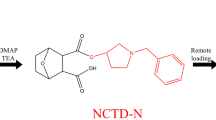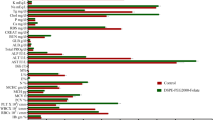ABSTRACT
Propose
Tin complexes demonstrate antiproliferative activities in some case higher than cisplatin, with IC50 at the low micromolar range. We have previously showed that the cyclic trinuclear complex of Sn(IV) bearing an aromatic oximehydroxamic acid group [nBu2Sn(L)]3 (L=N,2-dihydroxy-5-[N-hydroxyethanimidoyl]benzamide) (MG85) shows high anti-proliferative activity, induces apoptosis and oxidative stress, and causes destabilization of tubulin microtubules, particularly in colorectal carcinoma cells. Despite the great efficacy towards cancer cells, this complex still shows some cytotoxicity to healthy cells. Targeted delivery of this complex specifically towards cancer cells might foster cancer treatment.
Methods
MG85 complex was encapsulated into liposomal formulation with and without an active targeting moiety and cancer and healthy cells cytotoxicity was evaluated.
Results
Encapsulation of MG85 complex in targeting PEGylated liposomes enhanced colorectal carcinoma (HCT116) cancer cell death when compared to free complex, whilst decreasing cytotoxicity in non-tumor cells. Labeling of liposomes with Rhodamine allowed assessing internalization in cells, which showed significant cell uptake after 6 h of incubation. Cetuximab was used as targeting moiety in the PEGylated liposomes that displayed higher internalization rate in HCT116 cells when compared with non-targeted liposomes, which seems to internalize via active binding of Cetuximab to cells.
Conclusions
The proposed formulation open new avenues in the design of innovative transition metal-based vectorization systems that may be further extended to other novel metal complexes towards the improvement of their anti-cancer efficacy, which is usually hampered by solubility issues and/or toxicity to healthy tissues.



Similar content being viewed by others
Abbreviations
- DMPC:
-
Dimyristoylphosphatidylcholine
- DMPG:
-
Dimyristoylphosphoglycerol
- DSPE-PEG2000:
-
Distearoylphosphatidylethanolamine-poly(ethyleneglycol) 2000
- DSPE-PEG-NHS:
-
1,2-Distearoyl-sn-glycero-3-phosphoethanolamine-poly(ethylene-glycol)-2000-N-hydroxysuccinimide
- EGFR:
-
Epidermal growth factor receptor
- HCT116:
-
Colorectal carcinoma cells
- HepG2:
-
Hepatocellular carcinoma cells
- ICP:
-
Inductively Coupled Plasma Mass Spectrometry
- L:
-
Empty Liposomes
- MG85:
-
[nBu2Sn(L)]3 (L=N,2-dihydroxy-5-[N-hydroxyethanimidoyl]benzamide)
- MG85-L:
-
MG85 incorporated in conventional/non-PEGylated liposomes
- MG85-PEG-Rho-L-Cetuxi:
-
MG85 incorporated in Cetuximab targeted PEGylated liposomes labelled with Rho
- MPS:
-
Mononuclear phagocyte system
- PDI:
-
Polydispersity index
- PEG:
-
Polyethylene glycol
- PEG-Rho-L:
-
PEGylated liposomes labelled with Rho
- PEG-Rho–L-Cetuxi:
-
Cetuximab targeted PEGylated liposomes labelled with Rho
- PMA:
-
phorbol 12-myristate-13 acetate
- Rho:
-
Rhodamine B
- Rho-PE:
-
L-α-phosphoethanolamine-N-(lissamine Rhodamine B sulfonyl)
- THP1:
-
Human monocytic leukemia (THP1) cell line
REFERENCES
Varela-Ramirez M, Costanzo YP, Carrasco KH, Pannell, Aguilera RJ. Cytotoxic effects of two organotin compounds and their mode of inflicting cell death on four mammalian cancer cells. Cell Biol Toxicol. 2011;27:159–68. doi:10.1007/s10565-010-9178-y.
Gielen M. Organotin compounds and their therapeutic potential: a report from the organometallic chemistry department of the free University of Brussels. Appl Organomet Chem. 2002;16:81–494. doi:10.1002/aoc.331.
Hadjikakou SK, Hadjiliadis N. Antiproliferative and anti-tumor activity of organotin compounds. Coord Chem Rev. 2009;253:235–49. doi:10.1016/j.ccr.2007.12.026.
Pellerito L, Nagy L, Pellerito PM, Szorcsik A. Biological activity studies on organotin(IV)n+ complexes and parent compounds. J Organomet Chem. 2006;691:1733–47. doi:10.1016/j.jorganchem.2005.12.025.
Mahmudov KT, Guedes da Silva MFC, Kopylovich MN, Fernandes AR, Silva A, Mizar A, et al. Di- and tri-organotin(IV) complexes of arylhydrazones of methylene active compounds and their antiproliferative activity. J Organomet Chem. 2014;760:67–73. doi:10.1016/j.jorganchem.2013.12.019.
Sirajuddin M, Ali S, McKee V, Sohail M, Pasha H. Potentially bioactive organotin(IV) compounds: synthesis, characterization, in vitro bioactivities and interaction with SS-DNA. Eur J Med Chem. 2014;84:343–63. doi:10.1016/j.ejmech.2014.07.028.
Awang N, Kamaludin NF, Hamid A, Mokhtar NW, Rajab NF. Cytotoxicity of triphenyltin(IV) methyl- and ethylisopropyldithiocarbamate compounds in chronic myelogenus leukemia cell line (K-562). Pak J Biol Sci. 2012;15:833–8. doi:10.3923/pjbs.2012.833.838.
Alama A, Tasso B, Novelli F, Sparatore F. Organometallic compounds in oncology: implications of novel organotins as antitumor agents. Drug Discov Today. 2009;14:500–8. doi:10.1016/j.drudis.2009.02.002.
Gajewska M, Luzyanin KV, MFC G d S, Li Q, Cui J, Pombeiro AJL. Cyclic trinuclear diorganotin(IV) complexes—the first tin compounds bearing oximehydroxamate ligands: synthesis, structural characterization and high in vitro cytotoxicity. Eur J Inorg Chem. 2009;2009:3765–9. doi:10.1002/ejic.200900388.
Tabassum S, Pettinari C. Chemical and biotechnological developments in organotin cancer chemotherapy. J Organomet Chem. 2006;691:1761–6. doi:10.1016/j.jorganchem.2005.12.033.
Gielen M, Biesemans M, Willem R. Organotin compounds: from kinetics to stereochemistry and antitumour activities. Appl Organomet Chem. 2005;19:440–50. doi:10.1002/aoc.771.
Pettinari C, Marchetti F. In: Tin chemistry: fundamentals, frontiers, and applications. John Wiley & Sons, ch. 4; 2008. p. 454–468. doi:10.1002/9780470758090.
Silva A, Luis D, Santos S, Silva J, Mendo AS, Coito L, et al. Biological characterization of the antiproliferative potential of Co(II) and Sn(IV) coordination compounds in human cancer cell lines: a comparative proteomic approach. Drug Metabol Drug Interact. 2013;8:167–76. doi:10.1515/dmdi-2013-0015.
Bansal SS, Goel M, Aqil F, Vadhanam MV, Gupta RC. Advanced drug delivery systems of curcumin for cancer chemoprevention. Cancer Prev Res. 2011;4:1158–71. doi:10.1158/1940-6207.CAPR-10-0006.
Kaasgaard T, Andresen TL. Liposomal cancer therapy: exploiting tumor characteristics. Expert Opin Drug Deliv. 2010;7:225–43. doi:10.1517/17425240903427940.
Malam Y, Loizidou M, Seifalian AM. Liposomes and nanoparticles: nanosized vehicles for drug delivery in cancer. Trends Pharmacol Sci. 2009;30:592–9. doi:10.1016/j.tips.2009.08.004.
Mangiapia G, D’Errico G, Simeone L, Irace C, Radulescu A, Di Pascale A, et al. Ruthenium-based complex nanocarriers for cancer therapy. Biomaterials. 2012;33:3770–82. doi:10.1016/j.biomaterials.2012.01.057.
Mangiapia G, Vitiello G, Irace C, Santamaria R, Colonna A, Angelico R, et al. Anticancer cationic ruthenium nanovetors: from rational molecular design to cellular uptake and bioactivity. Biomacromolecules. 2013;14:2549–60. doi:10.1021/bm400104b.
Montesarchio D, Mangiapia G, Vitiello G, Musumeci D, Irace C, Santamaria R, et al. A new design for nucleolipid-based Ru(III) complexes as anticancer agents. Dalton Trans. 2013;42:16697–708. doi:10.1039/c3dt52320a.
Lopes SCA, Giuberti CS, Rocha TGR, Ferreira DS, Leite EA, Oliveira MC. Liposomes as Carriers of Anticancer Drugs. In: Rangel L, editor. Cancer treatment—conventional and innovative approaches. Chapter 4. InTech, 2013. doi:10.5772/55290.
Charron DM, Chen J, Zheng G. Theranostic lipid nanoparticles for cancer medicine. Cancer Treat Res. 2015;166:103–27. doi:10.1007/978-3-319-16555-4_5.
Cole JT, Holland NB. Multifunctional nanoparticles for use in theranostic applications. Drug Deliv Transl Res. 2015;5:295–309. doi:10.1007/s13346-015-0218-2.
Mamot C, Ritschard R, Wicki A, Stehle G, Dieterle T, Bubendorf L, et al. Tolerability, safety, pharmacokinetics, and efficacy of doxorubicin-loaded anti-EGFR immunoliposomes in advanced solid tumours: a phase 1 dose-escalation study. Lancet Oncol. 2012;13:1234–41. doi:10.1016/S1470-2045(12)70476-X.
Andresen TL, Jensen SS, Jørgensen K. Advanced strategies in liposomal cancer therapy: problems and prospects of active and tumor specific drug release. Prog Lipid Res. 2005;44:68–97. doi:10.1016/j.plipres.2004.12.001.
Kao HW, Lin YY, Chen CC, Chi KH, Tien DC, Hsia CC, et al. Biological characterization of cetuximab-conjugated gold nanoparticles in a tumor animal model. Nanotechnology. 2014;25:295102. doi:10.1088/0957-4484/25/29/295102.
Lehtinen J, Raki M, Bergström KA, Uutela P, Lehtinen K, Hiltunen A, et al. Pre-targeting and direct immunotargeting of liposomal drug carriers to ovarian carcinoma. PLoS One. 2012;7, e41410. doi:10.1371/journal.pone.0041410.
Lee J, Choi Y, Kim K, Hong S, Park HY, Lee T, et al. Characterization and cancer cell specific binding properties of anti-EGFR antibody conjugated quantum dots. Bioconjug Chem. 2010;21:940–6. doi:10.1021/bc9004975.
Hertlein L, Lenhard M, Kirschenhofer A, Kahlert S, Mayr D, Burges A, et al. Cetuximab monotherapy in advanced cervical cancer: a retrospective study with five patients. Arch Gynecol Obstet. 2011;283:109–13. doi:10.1007/s00404-010-1389-1.
Ocvirk J, Cencelj S. Management of cutaneous side-effects of cetuximab therapy in patients with metastatic colorectal cancer. J Eur Acad Dermatol Venereol. 2010;24:453–9. doi:10.1111/j.1468-3083.2009.03446.x.
Liu L, Cao Y, Tan A, Liao C, Gao F. Cetuximab-based therapy versus non-cetuximab therapy for advanced cancer: a meta-analysis of 17 randomized controlled trials. Cancer Chemother Pharmacol. 2010;65:849–61. doi:10.1007/s00280-009-1090-x.
Medina OP, Zhu Y, Kairemo K. Targeted liposomal drug delivery in cancer. Curr Pharm Des. 2004;10:2981–9. doi:10.2174/1381612043383467.
Corvo ML, Marinho HS, Marcelino P, Lopes RM, Vale CA, Marques CR, et al. Superoxide dismutase enzymosomes: carrier capacity optimization, in vivo behaviour and therapeutic activity. Pharm Res. 2015;32:91–102. doi:10.1007/s11095-014-1447-7.
Alavi SE, Esfahani MK, Ghassemi S, Akbarzadeh A, Hassanshahi G. In vitro evaluation of the efficacy of liposomal and pegylated liposomal hydroxyurea. Indian J Clin Biochem. 2014;29:84–8. doi:10.1007/s12291-013-0315-2.
de Menezes DE L, Pilarski LM, Allen TM. In vitro and in vivo targeting of immunoliposomal doxorubicin to human B-cell lymphoma. Cancer Res. 1998;58:3320–30.
Sapra P, Allen TM. Internalizing antibodies are necessary for improved therapeutic efficacy of antibody-targeted liposomal drugs. Cancer Res. 2002;62:7190–4.
Rouser G, Fkeischer S, Yamamoto A. Two dimensional then layer chromatographic separation of polar lipids and determination of phospholipids by phosphorus analysis of spots. Lipids. 1970;5:494–6.
ACKNOWLEDGMENTS AND DISCLOSURES
We acknowledge Fundação para a Ciência e a Tecnologia (FCT/MEC) for financial support (Project PTDC/BBB-NAN/1812/2012; UCIBIO UID/Multi/04378/2013; UID/DTP/04138/2013). We thank M.Gajewska for MG85 synthesis and P. Borralho from iMed for Cetuximab.
M. Luísa Corvo and Ana Soraia Mendo contributed equally to the work.
Author information
Authors and Affiliations
Corresponding authors
Electronic supplementary material
Below is the link to the electronic supplementary material.
ESM 1
(DOCX 18 kb)
Supplementary Figure S1
(JPG 32 kb)
Supplementary Figure S2
(JPG 41 kb)
Supplementary Figure S3
(JPG 30 kb)
Supplementary Figure S4
(JPG 47 kb)
Supplementary Figure S5
(JPG 33 kb)
Supplementary Figure S6
(JPG 44 kb)
Rights and permissions
About this article
Cite this article
Corvo, M.L., Mendo, A.S., Figueiredo, S. et al. Liposomes as Delivery System of a Sn(IV) Complex for Cancer Therapy. Pharm Res 33, 1351–1358 (2016). https://doi.org/10.1007/s11095-016-1876-6
Received:
Accepted:
Published:
Issue Date:
DOI: https://doi.org/10.1007/s11095-016-1876-6




